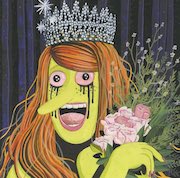|
Let's talk about painting! I am not a painter, but I do have a few bits of knowledge I've picked up! I would really like any painters or super paint pros to contribute and I can add your post to this one! PAINT  Disclaimer Disclaimer One of the hurdles to discussing painting online is that any pictures, screenshots, etc. will look different depending on the camera, lighting conditions, the monitor you are viewing it on, etc. So don't take what you see for granted! One of the hurdles to discussing painting online is that any pictures, screenshots, etc. will look different depending on the camera, lighting conditions, the monitor you are viewing it on, etc. So don't take what you see for granted!Whenever you are considering a paint, buy a sample can in whatever sheen you decide on (if in doubt, use eggshell). Paint a 1x1 foot square in several areas of the room that have different light exposure. Observe the paint over several days so you see how it does during daylight, cloudy weather, at night, etc. Try this with several paints of interest. Sample cans are typically <$10. 1) Sheens: Typically any paint will have different sheen options. The main difference is reflectivity. The more reflective, the easier it is to clean, but the more noticeable any sort of mistakes or defects will be as light will reflect more. The scale goes like this, from most to least reflective: high gloss semi-gloss satin eggshell matte flat Recommendations differ, but you pretty much always see flat on ceilings. Doors and trim are often satin or semi-gloss. Eggshell is the most "flexible" option and can do well on just about any wall.  2) Light Reflective Value (LRV): This is a percent indicating how much light the paint reflects. You should always take LRV into account when choosing your paint. Essentially the brighter the paint, the higher the LRV (you can think of "brighter" as an overall increase in the RGB values). Most paint websites will list the LRV along with the RGB values. If you have a room with a LOT of light, you want a lower LRV, so it doesn't get overwhelming! On the flipside, a room with less light would work well with a higher LRV paint. For example a living room with a lot of natural light might have a paint with an LRV of 50, but a room with less light might be closer to 60-80. The paint with the highest LRV (that I'm aware of) is this one at 92.2. In most color decks, samples on a card will have a common theme, and then be sorted by LRV. For example a sample of greens may be on one card, and then they will go in order of LRV/brightness. A dark green will be on one and, and a white with a green undertone will be on the other end. https://thelandofcolor.com/lrv-light-reflectance-value-of-paint-colors/  3) Choosing brushes/naps, etc.: - Need help with this one! Naps are used with rollers, and there are different sized naps for larger or smaller spaces, and naps suitable for different textures (for example mostly smooth walls vs. textured ceilings). 4) Latex vs. oil based paint: - In the vast majority of cases, you will be be better off using latex paint. Latex dries much faster, has less odor, and does not necessarily need a primer. Latex paints also try MUCH faster, often within 30-60 minutes. There may be very specific situations in which oil has some advantages (like painting metal), but for painting common surfaces like drywall I would definitely use latex. 5) Best paint for (insert situation here, i.e. interior, exterior, unusual surfaces, etc.): TBA - Need help on this one as well! 6) Cool vs Warm Paints and Lighting https://www.benjaminmoore.com/en-us/color-overview/color-insights/warm-and-cool-colors The basic idea here is that warm colors tend to have a different feel than cool colors, and their use depends on the specific situation.  However - something that is VERY important with all paint, and especially when looking at something a bit cool vs. a bit warm, is the color temperature coming into the room.  for most people, high color temperature lighting will typically only be found in areas where being able to discriminate between color is very important, and aesthetics less so - i.e. laundry room, garage, utility closet, etc. In other areas, most lighting will be in the 2700-3500K range. However daylight coming in through your window is 5000K. What does this mean? well, the lower the color temperature, the more it will emphasize the warmer parts of a paint, and vice versa. Consider what happened to me, considering two lighter grays: American White: 226 224 221 Silver Satin: 226 224 217 Obviously these are very similar - the only difference being that american white is relatively cooler than silver satin, as the blue is a bit higher. Here's a good way to visualize it - obviously color depends on your monitor, but it shows relative differences, and the vertical bar reflects color temperature pretty well. American White:  Silver Satin:  As you can see, the silver satin is just leaning a tad more towards yellow, which makes sense, as the blue is decreasing, i.e. it's becoming warmer, and if you were to continue to decrease the blue the color would get even more yellow. So what does this mean in practice? Well in my entry that was only getting artificial, 2700K, warm light, silver satin ended up looking a bit too yellow close to the light. It was the warmer color, and I was adding warm light, causing an increase in the yellowing effect. On the other hand, there was less yellowing with American White as it was a bit cooler. So it looked about as close to gray as you can get. BUT In the bedroom which only got daylight, i.e. cool light, this light helped cancel out the silver satin warmness. But what happened to American White? It pumped up that blue value, resulting in a very slight blue/purple undertone. And that makes sense if we look at the color wheel and up the blue a bit:  The point is, the color temperature of your paint AND very importantly the color temperature of your lighting make an enormous difference, even for colors that look to be very similar. This is why you always want to put your paint samples in all different areas, and expose them to daylight, artificial light, etc. at all times of day. 7) How to decide if a paint is right - This is very important! You want to get a sample, in the same sheen as you are interested in if possible, and paint squares at least 1x1 feet in size. You can use one of those really cheap foam brushes, and make sure you do two layers. Have at least one square on each wall, put it so it's partway behind major furnishings, and most importantly, paint at least one square right up against trim! Leave it there for a while (like a week), and observe it in all lighting conditions (especially important if you get a lot of natural light). edit: from a paint person below: Final Blog Entry posted:Oh hey I can help here! Without doxxing myself too much, I work in the paint industry on the manufacturer, retailer, and sales side mostly dealing with residential and commercial painters. Good job on the OP! I'm ok with color stuff but mostly leave that to our design folks and stick to products, speifications, and the like. actionjackson fucked around with this message at 15:47 on Dec 6, 2021 |
|
|
|

|
| # ? May 3, 2024 16:37 |
|
okay let's try another post  my three paints living room https://www.benjaminmoore.com/en-us/color-overview/find-your-color/color/OC-9/ballet-white?color=OC-9 picked this because while I have decent size windows, the light only comes in from one wall. So the higher LRV of 74 means the light that does come in will get reflected more, adding more brightness to the space. The brown undertone is to compliment other parts of the home, which is based around a blue/brown/gray theme. The biggest part of this is that I have chocolate brown countertops. There are brighter options, but they would contrast too much with the dark brown. bathroom https://www.sherwin-williams.com/homeowners/color/find-and-explore-colors/paint-colors-by-family/SW6242-bracing-blue A blue with a gray undertone. Works well with my new matte dark gray tile. My shower curtain is mostly a softer blue with a bit of brown. entry and bedroom https://www.benjaminmoore.com/en-us/color-overview/find-your-color/color/HC-170/stonington-gray?color=HC-170
|
|
|
|
Oh hey I can help here! Without doxxing myself too much, I work in the paint industry on the manufacturer, retailer, and sales side mostly dealing with residential and commercial painters. Good job on the OP! I'm ok with color stuff but mostly leave that to our design folks and stick to products, speifications, and the like. To expand on some of the points above- 3) Choosing brushes/naps, etc. This is going to be a function of the paint product, substrate, and personal preference. You're generally going to be using 9" rollers on open areas like walls, ceilings, and floors, or 4-6" mini rollers as needed for small areas and tight spaces. Nap size is the thickness of the pile, and you'll usually see 1/4"- 1 1/2" naps available. Smoother surface= smaller nap, rougher surface= thicker nap. A thicker nap will also hold more paint, but that becomes a trade off for quality of the finish. Use 1/4" for smooth doors, cabinets, etc. 3/8" or 1/2" for smooth or orange peel walls. 3/4" - 1" for knockdown, spanish lace, etc. 1.25" and 1.5" would be for heavy stucco and similar very rough textures. Then there's the actual fabric and construction. Nap materials will be nylon, polyester, nylon/poly blends, microfiber, mohair, and a few oddballs not worth mentioning. Different paints will like different nap material and your best bet is to go with whatever the paint manufacturer recommends. They test their paints with different applicators for the best results, so use what the can or data sheet says. Premium roller cover brands like Purdy and Wooster may have similar or identical materials to their cheaper counterparts but will usually be denser and worth the extra couple bucks for holding more paint and laying it on better. Brushes are all either natural (also called China bristle) or synthetic bristles. Natural/China is for oil based paint only. Synthetics can be used with all paints. The synthetic filaments you'll generally see are Nylon, Polyester, and Chinex. Nylon by itself is soft but not durable. Polyester by itself is stiff and durable but poo poo for finish quality. Nylon/poly blend is your best bet for a general purpose brush with medium stiffness. Chinex adds some stiffness and is great at holding paint. A nylon/poly/chinex blend is nice for rough textures like stucco. A lot of pros are preferring the 100% Chinex these days for stiffness and holding paint, but as a hack amateur I'll stick with the same nylon/poly and nylon/poly/chinex brushes I've had and maintained for the last 10+ years. Take care of your brushes and they'll last a drat long time for your average homeowner. Brush size and angle/straight is really preference and what you're trying to paint. 2.5" or 3" angle brushes are my preference for almost any general cutting in or trim painting. Just like roller covers, you get what you pay for. Premium brushes and cheaper brushes may have the exact same filaments but the Purdy or Wooster will have more density in the bristles and be better flagged or tipped at the ends of the bristles for better application. 4) Latex vs. oil based paint: Everything stated above and I'll add a bit. Latex paint technology has come a long way and there's less and less reason to use oil these days. Interior and exterior wall paints are really only ever going to be waterbased (with rare exceptions). Oils are generally used where you want a very hard and durable finish like doors, cabinets, and trim, but good latex enamels are great for those surfaces these days. Oil paint yellows over time, has poor UV resistance, is very prone to mildew, and can get brittle as it ages. The general rule of thumb is that you can put oil over latex, but not latex over oil. Oil based primers are different than oil paints and can accept either oil or waterbased topcoats. Specialty oil primers can be the best option for things like stainblocking or rusty surfaces, but you can pair those with a good latex topcoat for great results. 5) Best paint for (insert situation here, i.e. interior, exterior, unusual surfaces, etc.): Hard to get too in depth on this one, but the biggest thing is don't go cheap on your paint. You get what you pay for. For interior paint, there are a lot of special feature paints out there like stain resistance, antimicrobial paints, odor reducing paints, and even microbicidal paints that can kill bacterias on the paint film. And one thing I can't stress enough- "paint and primer in one" is total marketing bullshit. Behr pulled that out of their rear end years ago and then every other manufacturer had to follow suit to keep up with the hype. Paint is paint and primer is primer. If you need a primer then you need to get the right primer and use it, whether it's to seal bare suraces, block stains, or stick to a slick surface. Previously painted surfaces in sound condition that are clean, dry, and dull generally do not require any kind of primer, even of your paint isn't "paint and primer in one". Final Blog Entry fucked around with this message at 04:05 on Jul 10, 2021 |
|
|
|
This is a perfectly timed topic, as I am just starting to repaint stuff in my house! Thanks for the helpful advice, Final Blog Entry and actionjackson. I'll probably be coming back very soon for some colour-choosing advice, as that's going to be the next step. Specifically I'm starting with kitchen cabinets, as I want the kitchen to be finished ASAP since I love cooking, and we are hoping Anyway, I'm figuring out how to use Smart Strip Paint Remover, as my POs were... very judicious with their paint application on about half of my cabinets/drawers. Seems like a good product so far, I definitely need to layer it on thicker than I first did, as the thicker the application the easier it is to scrape the paint off. I'm looking at probably 5 drawer fronts, and another 3 full cabinet doors, that will need to be stripped this way, TSP-PF'd, sanded then started fresh with a layer of primer. I'm hoping the actual cabinetry can just be sanded down with an orbital, but I'm also preparing for the worst I'm contemplating trying the paint remover on the hinges, as literally everything is painted over in this loving house. I mean everything. Those little snap-in dealies that let you adjust shelf height in cabinets? Fuckin completely painted over. Every screw, hinge, air register, hell even part of the door adjacent to some cabinetry. Honestly, I'm guessing it'll probably be easiest and best to just replace the hinges, but I've never hung cabinet doors - is it incredibly complicated?
|
|
|
|
I would definitely just get new hinges (Blum blumotion is really nice), I've heard getting them aligned properly can be a pain but have no personal experience. I'm going to be getting new doors and drawers and am just having the place do everything (painting, attaching hardware, hinges, etc.)
|
|
|
|
The number one thing I learned from professional painters is that you don't have to use tape, just don't paint where the paint isn't supposed to be. So. I use tape. The number two thing I learned which is why I hire professional painters: prep is just as important as the painting itself. Plan your project so that you have time to wash down all the walls involved, wash baseboards and moulding, window-sills. Even if you're changing up a wall colour without redoing the trim, the trim is going to look ghastly if you don't give it some soap and water. Then of course, make sure you have budgeted time for any patching up, and for spackle or wood filler to have dried properly. And if you're going to need to tape, budget the time for that. Other things I learned along the way: just the tip of the paintbrush goes in the paint can. The roller is also not supposed to make a splorching noise. Roll excess paint back off it onto the paint tray after you load it. These things may seem obvious, but they weren't obvious to me. Also, if there are two of you working on a room, the coordinated one being dedicated to cutting in while the other one follows after them to ensure that they're working wet to wet is a pretty decent process. Regarding colour selection, one thing I learned from a professional colour theorist was to make sure that whatever you choose for the area where you're going to be applying makeup does not throw off light that is going to make it difficult to get a true colour read on your eyeshadow. The same, of course, applies for any room where making colour choices will happen. I am not a huge fan of white, but if you're painting a sewing studio, you probably aren't going to want to use a strong colour that will distort your ability to read textile colours. Idlewild_ fucked around with this message at 06:55 on Jul 10, 2021 |
|
|
|
Idlewild_ posted:Other things I learned along the way: just the tip of the paintbrush goes in the paint can. The roller is also not supposed to make a splorching noise. Roll excess paint back off it onto the paint tray after you load it. To a point sure, but good brushes and rollers are made to hold some paint and then it's up to you to unload it evenly on the wall. Sure, you don't want paint just running off your brush or roller onto the floor before you even get it on the wall, but if you're wiping all the paint off your brush on the edge of the can or unloading most of your roller on your tray or grid you're not doing yourself any favors. Don't be sby to get some paint on the wall, proper millage (thickness) is key to having good durability, washability, and touchup down the road. Also to avoid unnecessary additional coats that no one wants to do.
|
|
|
|
Idlewild_ posted:The number one thing I learned from professional painters is that you don't have to use tape, just don't paint where the paint isn't supposed to be. Paint will always leech under tape, you will never get as nice a line as you would by just learning to cut in properly, which honestly isn't difficult. If you do still want to use tape, practice cutting in while using the tape so that you minimize how much ends up leeching under it, and can eventually just stop using it.
|
|
|
|
Slugworth posted:Paint will always leech under tape, you will never get as nice a line as you would by just learning to cut in properly, which honestly isn't difficult. Salacious lies! (I am so, so bad at painting.  ) )
|
|
|
|
Are there any special considerations for re-painting bathroom walls/ceilings or other spots that generally are more humid/might get more water exposure?
|
|
|
|
El Mero Mero posted:Are there any special considerations for re-painting bathroom walls/ceilings or other spots that generally are more humid/might get more water exposure? All I can say is that I'm having my bathroom repainted soon and the painter highly recommended SW Cashmere. Going with eggshell. https://www.sherwin-williams.com/homeowners/products/cashmere-interior-acrylic-latex
|
|
|
|
I'd consider bumping up a step to SW Duration Home over the Cashmere. The Duration is anti-microbial while the Cashmere is not so it would give you better mildew resistance if that bathroom doesn't vent well. The Duration is also more resistant to moisture and water spotting.
|
|
|
|
Final Blog Entry posted:I'd consider bumping up a step to SW Duration Home over the Cashmere. The Duration is anti-microbial while the Cashmere is not so it would give you better mildew resistance if that bathroom doesn't vent well. The Duration is also more resistant to moisture and water spotting. I just asked my painter about this, but he pointed out it doesn't come in eggshell. Also for my specific paint (SW 6242 bracing blue) it actually only comes in flat for some reason? actionjackson fucked around with this message at 16:06 on Jul 13, 2021 |
|
|
|
Duration Home comes in Matte or Satin, not sure how Cashmere Eggshell's sheen compares to those though as I've never seen it. The Matte has a really nice soft sheen, very washable without being too shiny. That color can be made in any product and finish, as long as the store has the right tint base in stock
|
|
|
|
Hi this might actually be the right thread? Iím looking to paint a smallish (almost 2.5M by 2.5M) and Iíd like to know a few things - the wall is primed* but I want to paint with artist acrylics - is there anything I should keep in mind? - To transfer the potential design, Iím going to get a projector and just pop it onto the wall, drawing the design with a pencil OR should I use something else - other things to keep in mind? *its white paint on top of accursed and sanded garbage wallpaper
|
|
|
|
Final Blog Entry posted:Duration Home comes in Matte or Satin, not sure how Cashmere Eggshell's sheen compares to those though as I've never seen it. The Matte has a really nice soft sheen, very washable without being too shiny. That color can be made in any product and finish, as long as the store has the right tint base in stock Hmm okay. In either case I'm not sure if I would want matte as it's a low LRV paint, and the room doesn't get any direct natural light. It's a small bathroom and it just has a fixture above the vanity mirror.
|
|
|
|
I checked the actual sheen levels on the data sheets- Duration Matte 2-7 units Cashmere Eggshell 11-17 units Duration Satin 15-20 units So the Duration Satin is just a hair shinier than the Cashmere Eggshell, hard to say if noticeably so. The Matte would be significantly flatter. For the most part, Sherwin Williams uses Eggshell and Satin interchangeably, going with the Eggshell name on most commercial/contractor grade paints and Satin for the premium and retail-marketed paints, with the actual sheen levels being pretty comparable. Cashmere is kind of an outlier, being that it's definitely a "premium" paint with the Eggshell badging.
|
|
|
|
Nice timing thread! Iím in the middle of building my own house. I have my insulation inspection tomorrow, and drywall is being installed the following week. We are in the process of picking paints right now for the entire house. We have a Sherwin Williams right in town so we are going to go there to get some ideas. My wife and I are both very indecisive about colors, but we both hate boring beiges. Iím afraid if I let my wife pick all the colors we will end up with a clown house of bright colors that donít coordinate so this should be a fun process of me trying to tone everything down a bit and using color palettes to try and get some coordination going on. Wish me luck. Or donít, and I will post pictures of the Crayola Funhouse when we are done painting.
|
|
|
|
Final Blog Entry posted:I checked the actual sheen levels on the data sheets- ok, thanks for the info. as i said I already had the paint made, but we'll see how it goes! I do always run the fan after showering until all the steam is gone off the mirror.
|
|
|
|
Ah oops, I missed that you already had it tinted up. Carry on then!
|
|
|
|
Final Blog Entry posted:Ah oops, I missed that you already had it tinted up. Carry on then! All good, I appreciate the expert paint info! Also I think your post was originally in response to someone else who is still looking to paint a bathroom, so maybe it will help them! One thing I am wondering about, actually speaking about my ceiling - it's popcorn texture, and the original owners thankfully left the exact paint they used (it was put on probably 10-11 years ago when I bought it from them). I used a small roller a nap for rough surfaces as it was just a few small areas (wooster pro 3/4" nap). Thherere was one area where they had not removed a light fixture before painting, so when I removed it the area the light had covered was more gray than the rest of the ceiling. I went over this I think three times, making sure to also go a bit into the area that was painted (i.e. just outside the gray "ring"). This ended up looking REALLY good. No one would ever notice unless they knew it was painted, and even then you have to look kind of hard to see the ring. On the other hand there are a couple spots very close by where there used to be two track light fixtures, which I removed because ugh track lighting. And of course the area where the track was was unpainted as well. I think I did two rolls, but definitely not as much as with that first ring previously mentioned. The area I painted is noticeable whiter in this case - nothing super drastic, but noticeable. I'm wondering if this is because a) I need to do another coat b) I didn't go past the "border" enough into the area that had been previously painted enough c) maybe this area of the ceiling is just hit by the light differently, causing the difference? Sorry for the bad picture - it's very overcast out today, and turning on the kitchen light would make it harder to see the ceiling I wanted to highlight. But you can see the two spots I mentioned last with the arrows, and then the first part I mentioned is just inside that black circle - not really noticeable at all!
|
|
|
|
Since it looks like those spots are more over your kitchen, I'm wondering if that end of the ceiling might be ever so slightly stained from 11 years of cooking underneath it.
|
|
|
|
Final Blog Entry posted:Since it looks like those spots are more over your kitchen, I'm wondering if that end of the ceiling might be ever so slightly stained from 11 years of cooking underneath it. yeah I suppose that's possible, the closer area is actually above a barstool height counter which really has never had anything on it. Sorry the picture doesn't show it, but the further away fixture is centered over a small galley kitchen floor, with the fridge and the ovens on the far wall, and the dishwasher in sink on the other side, between where the two areas highlighted by the arrows are located. I did notice that another small area further away has something similar, even though it's squarely above the living room. it's another concealer where there was just a small ring around it, and it's pretty much in line with the closer concealer in that pic. actionjackson fucked around with this message at 20:15 on Jul 14, 2021 |
|
|
|
actionjackson posted:b) I didn't go past the "border" enough into the area that had been previously painted enough
|
|
|
|
Thanks!
|
|
|
|
Modus Man posted:Nice timing thread! Iím in the middle of building my own house. I have my insulation inspection tomorrow, and drywall is being installed the following week. We are in the process of picking paints right now for the entire house. We have a Sherwin Williams right in town so we are going to go there to get some ideas. Every room in my house is a different color, we pick them based on what we feel like. The only white walls in our house is the hallway that connects all the room. Don't be afraid to go with colors you like in all the rooms!
|
|
|
|
My house was built in 1931, and all the interior walls are beadboard. There are multiple different kinds of beadboard in any given room, ranging from 1/8" deep or less to 1/4" deep. Am I doomed to paint all of this with a brush because the height differential is so substantial, or are there kinds of roller that would work?
|
|
|
|
Arsenic Lupin posted:My house was built in 1931, and all the interior walls are beadboard. There are multiple different kinds of beadboard in any given room, ranging from 1/8" deep or less to 1/4" deep. Am I doomed to paint all of this with a brush because the height differential is so substantial, or are there kinds of roller that would work? for some reason I thought beadboard was only used on ceilings, do you have a picture?
|
|
|
|
Sorry, won't imbed. https://imgur.com/a/vDcLth6
|
|
|
|
i'm just going to guess you will need a brush, but maybe you could find a really narrow roller? I've never seen one that narrow though.
actionjackson fucked around with this message at 04:03 on Jul 18, 2021 |
|
|
|
This thread inspired me to attack the worst painted room in my place: the bathroom. The awful previous owner did a horrible job painting and put heavy layers of cheap latex paint on top of un-prepped, un-primed oil paint. I just finished pulling it off and it (for the most part) slid off the walls in gigantic sheets. I took the opportunity to also replace the bathroom fan and install actual ducting above it (loving PO.) Here's where I'm at tonight:  Plan for tomorrow: 1. Sand 2. Replace the joint tape 3. Mix up sheetrock 45 and smooth out the holes and janky bits and corners. let that dry. 4. sand 5. Wash with tsp 5. Prime and dry with zinsser primer 6. 1st coat and dry 7. 2nd coat and dry Does that sound like the right order of operations here? Also, some of the old latex didn't peel up like the rest (maybe it bonded correctly in some spots?) Is it okay to leave it or do I need to sand it down or something.
|
|
|
|
Arsenic Lupin posted:My house was built in 1931, and all the interior walls are beadboard. There are multiple different kinds of beadboard in any given room, ranging from 1/8" deep or less to 1/4" deep. Am I doomed to paint all of this with a brush because the height differential is so substantial, or are there kinds of roller that would work?
|
|
|
|
Slugworth posted:You could probably use a deep nap roller pretty effectively, but understand that the deeper the nap, the rougher the finish. It might be a fair trade off though, if it means not brush painting the whole house. Thanks! Fortunately we're only doing a few rooms. I'm going to do one of the bathrooms as a test; they're tiny, and if the paint is too rough to deal with, we'll do it with foam notch-ended brushes (the grooves) and rollers (the flat bits).
|
|
|
|
A foam corner roller may work well to roll into the grooves first and then come back with a 3/8" or so nap to face off everything else https://www.homedepot.com/p/FoamPRO-1-1-4-in-Corner-Roller-156409/205037121
|
|
|
|
Genius. Thank you.
|
|
|
|
El Mero Mero posted:This thread inspired me to attack the worst painted room in my place: the bathroom. You might want to hit above the shower with some mold/mildew killer (I can't tell if that's just dirt or something growing on the ceiling), unless the primer you're using has that in it. I'd definitely plan on repeating 3 & 4 a few times - especially if you bring in another light to project up from the floor. You can definitely find a lot more areas to fix by varying where the light comes from.
|
|
|
|
devicenull posted:You might want to hit above the shower with some mold/mildew killer (I can't tell if that's just dirt or something growing on the ceiling), unless the primer you're using has that in it. Yeah, we attacked the mold too and the primer had some stuff in it too. Your advice on 3/4 multiple times was pretty prescient. I wrapped up my first coat today and there were some hard paint edges from the old paint still showing through and a couple missed divots that are really clear through that coat (here's a photo). I'm kicking myself a bit. Whelp, I've got lots of 45 and enough paint/primer to do those spots all over again El Mero Mero fucked around with this message at 05:19 on Jul 19, 2021 |
|
|
|
I'm going to be painting a room that will need two gallons of paint. I'll be using Ben Moore Regal Select eggshell Should I mix them in a larger bucket to make sure the color is exactly the same across the cans?
|
|
|
|
It's recommended but probably not necessary for color consistency if you buy the gallons at the same time from the same place. But working out of a five gallon bucket with a bucket grid is way easier than working out of a little roller tray so you should dump them together for that reason.
|
|
|
|

|
| # ? May 3, 2024 16:37 |
|
I've noticed sometimes when I do small paint touchups they blend perfectly from straight on but stick out like crazy viewed from shallower angles. What is going on and how do I avoid that?
|
|
|























